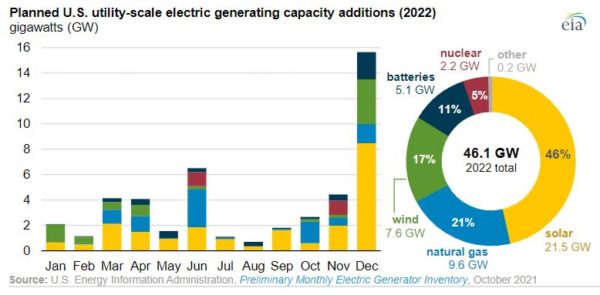The Energy Information Administration (EIA) expects 46.1 GW of new utility-scale electric generating capacity to be added to the U.S. power grid in 2022. Nearly half (46%) of which will be solar, followed by natural gas (21%) and wind (17%). The data is assembled by the EIA in a series of monthly and annual electric generator surveys, which ask developers to share their planned activation dates for projects in a five-year horizon.
Utility-scale solar Is projected to grow by 21.5 GW this year. The planned capacity marks significant growth from 2021’s 15.5 GW of capacity additions, an estimate based on the 8.7 GW of solar additions through October this year, and scheduled additions for the last two months of 2021 (6.9 GW).

Texas is expected to lead all states in utility-scale development this year, with 6.1 GW on the way, representing 28% of the national total. California is expected to add roughly 4 GW of generating capacity this year.
California’s development could speed up some, as the California Public Utilities Commission (CPUC) issued a mandate to attach an additional 11.5 GW of renewable energy to the grid by 2025. Community choice aggregators in the state are actively requesting proposals for projects containing solar and long duration energy storage of eight hours or more.
The EIA expects a sharp, 84%, increase in battery energy storage this year, with 5.1 GW of capacity expected to come online. Declining costs, co-deployment with renewable generation, and added value through regional transmission organization markets are driving growth in the technology, said EIA.
This content is protected by copyright and may not be reused. If you want to cooperate with us and would like to reuse some of our content, please contact: editors@pv-magazine.com.









That’s not at all disappointing as far as solar goes. It is disappointing as far as wind goes. In spite of the numerous online comments about solar being the cheapest source of new electricity that is only true in some places. In many places wind is cheaper, and due to a higher capacity factor wind is the optimum resource to provide renewable energy, even if solar is cheaper in many places.
The way I see it, if solar plus storage gets cheaper than wind, then it’s a free-for-all. But until that happens, the optimum energy supply for the U.S. is about 60% wind, 30% solar and 10% all other renewables.
In the best possible spirit of support, let’s criticize the identification of storage as a generation resource. It is related, but it is not the same. EIA treats it as a negative number in most of their reports.
Also, I would have liked to see the relationship between the new natural gas and the expected natural gas retirements. For the last three years U.S. natural gas additions have been less than fossil retirements. I haven’t made sure that it was also less than natural gas retirements.